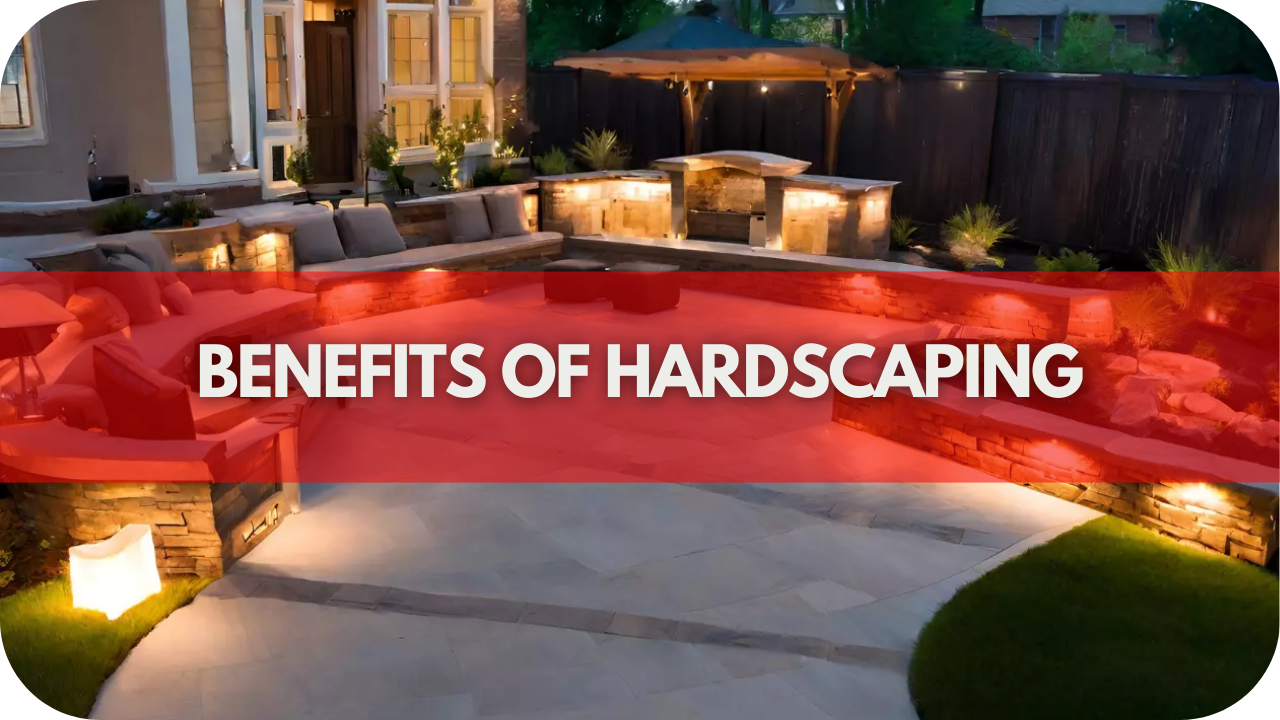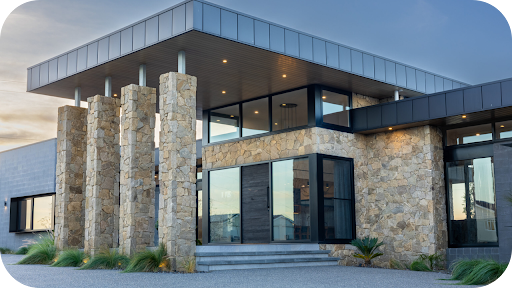
Many homeowners struggle to enhance their outdoor spaces, finding traditional landscaping time-consuming and costly.
A lacklustre garden often fails to add value to the home or provide a pleasant outdoor living area. Without the right approach, your garden can become a source of stress rather than enjoyment.
Hardscaping offers a low-maintenance, visually appealing solution that enhances your property’s value and creates beautiful, functional outdoor spaces. Discover the transformative benefits of incorporating hardscaping into your home.
1. Enhancing Aesthetic Appeal
Transforming your outdoor space with hardscaping enhances its visual appeal and significantly increases your home’s value. Using a mix of stone, concrete, and wood, you can craft designs that perfectly echo your home’s architectural style, creating distinctive visual statements.
Strategic elements such as natural stone pathways, elegant retaining walls, and decorative features add functionality and aesthetic allure, serving as captivating focal points.
The versatility of hardscaping materials unleashes endless creative possibilities. This integration boosts curb appeal and sets your property apart from others in the neighbourhood, making hardscaping a wise investment.
Well-designed hardscaping transforms a simple garden into a stunning outdoor retreat that remains attractive and functional throughout the year.
Hardscaping is also an environmentally friendly choice. It can help manage soil erosion and water runoff, further enriching your garden’s ecosystem.
2. Increasing Property Value
Investing in hardscaping can significantly enhance your property’s market value by elevating your outdoor environment’s aesthetic and functional aspects. Stone walkways and strategically placed lighting do more than improve the first impression of your home; they create an inviting atmosphere that captivates prospective buyers. Incorporating elegant design elements can further refine the landscape and distinguish your property.
Furthermore, hardscaping extends usable living space by adding patios, decks, and outdoor kitchens. These features are particularly sought after for their ability to transform a simple backyard into a vibrant area for entertainment and relaxation.
Using durable, high-quality materials like stone and concrete ensures these spaces are low maintenance and long-lasting, adding enduring value to the property.
In addition, hardscaping offers significant environmental benefits that resonate with today’s eco-conscious buyers. Permeable pavers and other sustainable materials help manage water runoff, prevent soil erosion, and support conservation efforts.
3. Expanding Usable Outdoor Space
Hardscaping can transform underused areas of your garden into functional, appealing spaces, optimising your outdoor environment for various activities.
Patios and decks provide a robust foundation for outdoor furniture, making them perfect for dining, lounging, and year-round entertainment. These structures use durable materials like stone, concrete, or wood, ensuring longevity and minimal maintenance.
Pergolas and gazebos not only add elegance but also offer shade and protection from the elements, extending the usability of your outdoor space across different weather conditions. Pathways and walkways enhance accessibility, seamlessly connecting diverse garden areas such as seating nooks, fire pits, and flower gardens, which helps create a cohesive landscape.
Terracing and retaining walls are crucial in managing slopes, uneven terrain, and flat surfaces that serve multiple functions. Lastly, installing features like outdoor kitchens and fire pits can dramatically increase the functionality of your garden, establishing it as a favoured gathering spot that remains attractive and useful regardless of the season.
4. Low-Maintenance Landscaping
Hardscaping provides a practical solution for those seeking a beautiful garden without high maintenance. Hardscaping significantly reduces regular garden upkeep tasks like watering, pruning, or fertilizing by incorporating stone, concrete, and brick. These durable materials are resilient and eliminate the frequent need for garden maintenance.
Hardscaping effectively reduces areas where weeds can flourish by covering the soil with patios, walkways, and gravel beds, which minimises the need for constant weeding and herbicide applications. This coverage also helps stabilise the soil, preventing erosion and reducing the need for frequent soil replenishment.
Additionally, hardscape materials’ robust nature means they can withstand various weather conditions, from harsh sunlight to heavy rain and frost. This weather resistance ensures your garden remains functional and attractive throughout the year.
Furthermore, hardscaped surfaces are straightforward to clean—requiring regular sweeping and occasional washing—contrasting sharply with the labour-intensive care needed for traditional lawns and plant beds.
5. Improving Safety and Accessibility
Hardscaping significantly enhances the safety and accessibility of your outdoor spaces, making them more user-friendly for everyone. Stable surfaces like hardscaped paths, patios, and driveways provide even footing, reducing the risk of trips and falls with non-slip materials like pavers, concrete, and stone, which are especially useful in wet conditions.
Integrating outdoor lighting into the design improves visibility, ensuring safe navigation at night and adding aesthetic appeal to your garden. Wide, smooth pathways make the garden accessible to those with mobility issues, enhancing inclusivity.
Additionally, incorporating ramps and handrails in your hardscape design aids individuals with disabilities, facilitating movement across different garden levels. Properly constructed retaining walls and steps manage elevation changes securely, preventing soil erosion and enhancing safety while also offering the potential for additional seating or decorative elements.
6. Enhancing Environmental Sustainability
Hardscaping enhances the aesthetic appeal of your garden and promotes environmental sustainability by integrating eco-friendly design principles. Permeable pavers play a crucial role by allowing water to seep through, thus reducing runoff and promoting groundwater recharge. This is essential for effective stormwater management, which helps prevent erosion and waterlogging.
In areas susceptible to drought, hardscaped features such as patios, walkways, and driveways significantly reduce water consumption as they require no watering. Structures like retaining walls and terraces also stabilise the soil and prevent erosion, preserving the landscape’s integrity and reducing sediment runoff into local waterways.
Using materials that reflect rather than absorb sunlight can help mitigate the urban heat island effect, which is particularly beneficial in densely populated areas. The durability of hardscaping materials means they are replaced less frequently.
Furthermore, hardscaping’s low maintenance minimises the need for chemical treatments such as fertilisers and pesticides, promoting a healthier and more sustainable environment.
7. Personal Well-being and Health Benefits
Hardscaping can significantly enhance your well-being and overall health by transforming your outdoor space into a sanctuary of relaxation and recreation. A thoughtfully designed hardscape contributes to stress reduction by creating a tranquil environment.
Features such as water fountains, serene pathways, and quiet seating areas offer a peaceful retreat from the demands of daily life. Hardscaped areas like patios, decks, and walking paths also encourage outdoor activities, promoting physical health through yoga on the terrace, leisurely strolls along garden paths, or social gatherings around a fire pit.
These spaces also foster social interaction, providing ideal settings for hosting family and friends, vital for mental and emotional well-being. Moreover, incorporating natural elements like stone and wood into your hardscape design helps you connect with nature, improving mood, reducing anxiety, and enhancing overall mental health.
Another benefit is enhanced safety, as stable, well-designed surfaces reduce the risk of injury, allowing confident movement around your garden, particularly for the elderly or those with mobility issues.
Conclusion
Incorporating hardscaping into your home elevates your outdoor space and boosts your well-being. The benefits are profound, from reducing stress to encouraging physical activity. Don’t miss the opportunity to transform your garden into a personal sanctuary. Start planning your hardscaping project today and experience the positive impact it can have on your life.
More To Explore

Grey Granite Cobblestones for Driveways: Strength and Style
Grey granite cobblestones combine strength, safety, and timeless appeal, making them a popular choice for Melbourne driveways and outdoor spaces. Their natural flamed texture offers

Granite Wall Cladding Melbourne: Modern and Classic Appeal
Granite wall cladding brings both modern sophistication and classic charm to Melbourne architecture. Known for its durability and natural beauty, granite transforms façades, feature walls,


